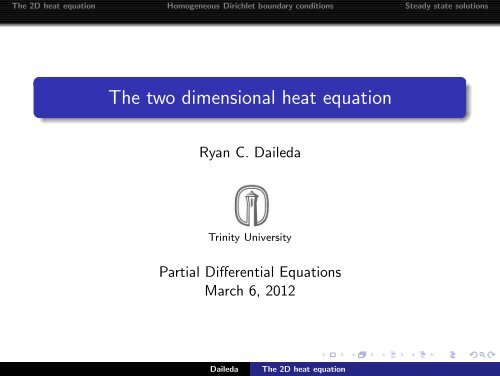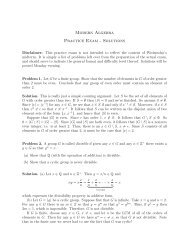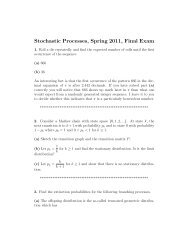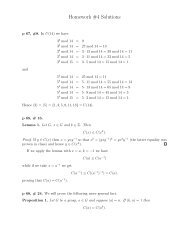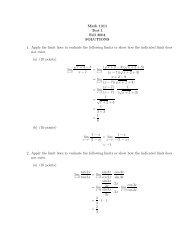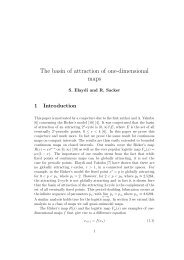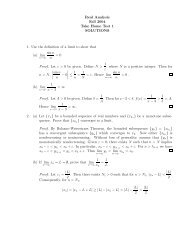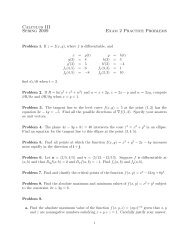The two dimensional heat equation - Trinity University
The two dimensional heat equation - Trinity University
The two dimensional heat equation - Trinity University
- No tags were found...
Create successful ePaper yourself
Turn your PDF publications into a flip-book with our unique Google optimized e-Paper software.
<strong>The</strong> 2D <strong>heat</strong> <strong>equation</strong> Homogeneous Dirichlet boundary conditions Steady state solutions<strong>The</strong> <strong>two</strong> <strong>dimensional</strong> <strong>heat</strong> <strong>equation</strong>Ryan C. Daileda<strong>Trinity</strong> <strong>University</strong>Partial Differential EquationsMarch 6, 2012Daileda<strong>The</strong> 2D <strong>heat</strong> <strong>equation</strong>
<strong>The</strong> 2D <strong>heat</strong> <strong>equation</strong> Homogeneous Dirichlet boundary conditions Steady state solutionsPhysical motivationConsider a thin rectangular plate made of some thermallyconductive material. Suppose the dimensions of the plate are a×b.<strong>The</strong> plate is <strong>heat</strong>ed in some way, and then insulated along itstop and bottom.Our goal is to mathematically model the way thermal energymoves through the plate.Daileda<strong>The</strong> 2D <strong>heat</strong> <strong>equation</strong>
<strong>The</strong> 2D <strong>heat</strong> <strong>equation</strong> Homogeneous Dirichlet boundary conditions Steady state solutionsWe letu(x,y,t) =temperature of plate at position (x,y) andtime t.For a fixed t, the height of the surface z = u(x,y,t) gives thetemperature of the plate at time t and position (x,y).Under ideal assumptions (e.g. uniform density, uniform specific<strong>heat</strong>, perfect insulation, no internal <strong>heat</strong> sources etc.) one canshow that u satisfies the <strong>two</strong> <strong>dimensional</strong> <strong>heat</strong> <strong>equation</strong>for 0 < x < a, 0 < y < b.u t = c 2 ∇ 2 u = c 2 (u xx +u yy ) (1)Daileda<strong>The</strong> 2D <strong>heat</strong> <strong>equation</strong>
<strong>The</strong> 2D <strong>heat</strong> <strong>equation</strong> Homogeneous Dirichlet boundary conditions Steady state solutionsAt the edges of the plate we impose some sort of boundaryconditions. <strong>The</strong> simplest are homogeneous Dirichletconditions:u(0,y,t) = u(a,y,t) = 0, 0 ≤ y ≤ b, t ≥ 0,u(x,0,t) = u(x,b,t) = 0, 0 ≤ x ≤ a, t ≥ 0. (2)Physically, these correspond to holding the temperature along theedges of the plate at 0.<strong>The</strong> way the plate is <strong>heat</strong>ed initially is given by the initialconditionu(x,y,0) = f(x,y), (x,y) ∈ R, (3)where R = [0,a]×[0,b].Daileda<strong>The</strong> 2D <strong>heat</strong> <strong>equation</strong>
<strong>The</strong> 2D <strong>heat</strong> <strong>equation</strong> Homogeneous Dirichlet boundary conditions Steady state solutionsSolving the 2D wave <strong>equation</strong>: homogeneous Dirichletboundary conditionsGoal: Write down a solution to the <strong>heat</strong> <strong>equation</strong> (1) subject tothe boundary conditions (2) and initial conditions (3).As usual, weseparate variables to produce simple solutions to (1) and(2), and thenuse the principle of superposition to build up a solution thatsatisfies (3) as well.Daileda<strong>The</strong> 2D <strong>heat</strong> <strong>equation</strong>
<strong>The</strong> 2D <strong>heat</strong> <strong>equation</strong> Homogeneous Dirichlet boundary conditions Steady state solutionsSeparation of variablesAssuming thatu(x,y,t) = X(x)Y(y)T(t),plugging into the <strong>heat</strong> <strong>equation</strong> (1) and using the boundaryconditions (2) yields the separated <strong>equation</strong>sX ′′ −BX = 0, X(0) = 0, X(a) = 0, (4)Y ′′ −CY = 0, Y(0) = 0, Y(b) = 0, (5)T ′ −c 2 (B +C)T = 0. (6)Daileda<strong>The</strong> 2D <strong>heat</strong> <strong>equation</strong>
<strong>The</strong> 2D <strong>heat</strong> <strong>equation</strong> Homogeneous Dirichlet boundary conditions Steady state solutionsWe have already seen that the solutions to (4) and (5) areX m (x) = sinµ m x,µ m = mπa ,B = −µ2 mY n (y) = sinν n y, ν n = nπ b , C = −ν2 n,for m,n ∈ N. Using these values in (6) givesT mn (t) = e −λ2 mnt ,where√mλ mn = c√µ 2 m +ν2 n = cπ 2a 2 + n2b 2.Daileda<strong>The</strong> 2D <strong>heat</strong> <strong>equation</strong>
<strong>The</strong> 2D <strong>heat</strong> <strong>equation</strong> Homogeneous Dirichlet boundary conditions Steady state solutionsSuperpositionAssembling these results, we find that for any pair m,n ≥ 1 wehave the normal modeu mn (x,y,t) = X m (x)Y n (y)T mn (t) = sinµ m x sinν n y e −λ2 mn t .For any choice of constants A mn , by the principle of superpositionwe then have the general solution to (1) and (2)u(x,y,t) =∞∑m=1 n=1∞∑A mn sinµ m x sinν n y e −λ2mnt .Daileda<strong>The</strong> 2D <strong>heat</strong> <strong>equation</strong>
<strong>The</strong> 2D <strong>heat</strong> <strong>equation</strong> Homogeneous Dirichlet boundary conditions Steady state solutionsInitial conditionsWe must determine the values of the coefficients A mn so that oursolution also satisfies the initial condition (3). We needf(x,y) = u(x,y,0) =∞∑∞∑n=1 m=1A mn sin mπa x sin nπ b ywhich is just the double Fourier series for f(x,y). We know thatif f is a C 2 function thenA mn = 4ab∫ a ∫ b00f(x,y)sin mπa x sin nπ bdy dx.Daileda<strong>The</strong> 2D <strong>heat</strong> <strong>equation</strong>
<strong>The</strong> 2D <strong>heat</strong> <strong>equation</strong> Homogeneous Dirichlet boundary conditions Steady state solutionsConclusion<strong>The</strong>oremSuppose that f(x,y) is a C 2 function on the rectangle[0,a]×[0,b]. <strong>The</strong> solution to the <strong>heat</strong> <strong>equation</strong> (1) withhomogeneous Dirichlet boundary conditions (2) and initialconditions (3) is given byu(x,y,t) =∞∑m=1 n=1∞∑A mn sinµ m x sinν n y e −λ2mnt ,where µ m = mπa , ν n = nπ √b , λ mn = c µ 2 m +ν2 n , andA mn = 4ab∫ a∫ b00f(x,y)sin mπa x sin nπ by dy dx.Daileda<strong>The</strong> 2D <strong>heat</strong> <strong>equation</strong>
<strong>The</strong> 2D <strong>heat</strong> <strong>equation</strong> Homogeneous Dirichlet boundary conditions Steady state solutionsRemarks:ExampleWe have not actually verified that this solution is unique, i.e.that this is the only solution to problem.We will prove uniqueness later using the maximum principle.A 2×2 square plate with c = 1/3 is <strong>heat</strong>ed in such a way that thetemperature in the lower half is 50, while the temperature in theupper half is 0. After that, it is insulated laterally, and thetemperature at its edges is held at 0. Find an expression that givesthe temperature in the plate for t > 0.Daileda<strong>The</strong> 2D <strong>heat</strong> <strong>equation</strong>
<strong>The</strong> 2D <strong>heat</strong> <strong>equation</strong> Homogeneous Dirichlet boundary conditions Steady state solutionsWe must solve the <strong>heat</strong> <strong>equation</strong> problem (1) - (3) with{50 if y ≤ 1,f(x,y) =0 if y > 1.<strong>The</strong> coefficients in the solution areA mn =42·2∫ 2 ∫ 20∫ 20f(x,y)sin mπ2 x sin nπ 2∫ 12 x dx sin nπ 2 y dy= 50 sin mπ0 0( 2(1+(−1) m+1 )() 2(1−cosnπ= 50πm πn= 200 (1+(−1) m+1 )(1−cos nπ 2 )π 2 .mny dy dx2 ))Daileda<strong>The</strong> 2D <strong>heat</strong> <strong>equation</strong>
<strong>The</strong> 2D <strong>heat</strong> <strong>equation</strong> Homogeneous Dirichlet boundary conditions Steady state solutionsSincethe solution isλ mn = π 3√m 24 + n24 = π √m62 +n 2u(x,y,t) = 200π 2 ∞ ∑m=1 n=1∞∑( (1+(−1) m+1 )(1−cos nπ 2 )mn×sin nπ 2 y e−π2 (m 2 +n 2 )t/36 ) .sin mπ2 xDaileda<strong>The</strong> 2D <strong>heat</strong> <strong>equation</strong>
<strong>The</strong> 2D <strong>heat</strong> <strong>equation</strong> Homogeneous Dirichlet boundary conditions Steady state solutionsSteady state solutionsTo deal with inhomogeneous boundary conditions in <strong>heat</strong>problems, one must study the solutions of the <strong>heat</strong> <strong>equation</strong>that do not vary with time.<strong>The</strong>se are the steady state solutions. <strong>The</strong>y satisfyu t = 0.In the 1D case, the <strong>heat</strong> <strong>equation</strong> for steady states becomesu xx = 0.<strong>The</strong> solutions are simply straight lines.Daileda<strong>The</strong> 2D <strong>heat</strong> <strong>equation</strong>
<strong>The</strong> 2D <strong>heat</strong> <strong>equation</strong> Homogeneous Dirichlet boundary conditions Steady state solutionsLaplace’s <strong>equation</strong>In the 2D case, we see that steady states must solve∇ 2 u = u xx +u yy = 0. (7)This is Laplace’s <strong>equation</strong>.Solutions to Laplace’s <strong>equation</strong> are called harmonicfunctions.See assignment 1 for examples of harmonic functions.Daileda<strong>The</strong> 2D <strong>heat</strong> <strong>equation</strong>
<strong>The</strong> 2D <strong>heat</strong> <strong>equation</strong> Homogeneous Dirichlet boundary conditions Steady state solutionsWe want to find steady state solutions to (7) that satisfy theDirichlet boundary conditionsu(x,0) = f 1 (x), u(x,b) = f 2 (x), 0 < x < a (8)u(0,y) = g 1 (x), u(a,y) = g 2 (y), 0 < y < b (9)<strong>The</strong> problem of finding a solution to (7) - (9) is known as theDirichlet problem.We will begin by assuming f 1 = g 1 = g 2 = 0.<strong>The</strong> general solution to the Dirichlet problem will be obtainedby superposition.Daileda<strong>The</strong> 2D <strong>heat</strong> <strong>equation</strong>
<strong>The</strong> 2D <strong>heat</strong> <strong>equation</strong> Homogeneous Dirichlet boundary conditions Steady state solutionsSolution of the Dirichlet problem on a rectangleGoal: Solve the boundary value problem∇ 2 u = 0, 0 < x < a, 0 < y < b,u(x,0) = 0, u(x,b) = f 2 (x), 0 < x < a,u(0,y) = u(a,y) = 0, 0 < y < b.Picture:Daileda<strong>The</strong> 2D <strong>heat</strong> <strong>equation</strong>
<strong>The</strong> 2D <strong>heat</strong> <strong>equation</strong> Homogeneous Dirichlet boundary conditions Steady state solutionsSeparation of variablesSetting u(x,y) = X(x)Y(y) leads toX ′′ +kX = 0 , Y ′′ −kY = 0,X(0) = X(a) = 0 , Y(0) = 0.We know the nontrivial solutions for X:X(x) = X n (x) = sinµ n x, µ n = nπ a , k = µ2 n .for n ∈ N = {1,2,3,...}. <strong>The</strong> corresponding solutions for Y areY(y) = Y n (y) = A n e µny +B n e −µny .Daileda<strong>The</strong> 2D <strong>heat</strong> <strong>equation</strong>
<strong>The</strong> 2D <strong>heat</strong> <strong>equation</strong> Homogeneous Dirichlet boundary conditions Steady state solutions<strong>The</strong> condition Y(0) = 0 yields A n = −B n . Choosing A n = 1/2 wefind thatY n (y) = sinhµ n y.This gives the separated solutionsu n (x,y) = X n (x)Y n (y) = sinµ n x sinhµ n y,and superposition gives the general solutionu(x,y) =∞∑B n sinµ n x sinhµ n y.n=1Daileda<strong>The</strong> 2D <strong>heat</strong> <strong>equation</strong>
<strong>The</strong> 2D <strong>heat</strong> <strong>equation</strong> Homogeneous Dirichlet boundary conditions Steady state solutions<strong>The</strong> general solution satisfies the Laplace <strong>equation</strong> (7) inside therectangle, as well as the three homogeneous boundary conditionson three of its sides (left, right and bottom).We now determine the values of B n to get the boundary conditionon the top of the rectangle. This requiresf 2 (x) = u(x,b) =∞∑n=1B n sinh nπbasin nπ a x,which is the Fourier sine series for f 2 (x) on 0 < x < a.Appealing to previous results, we can now summarize our findings.Daileda<strong>The</strong> 2D <strong>heat</strong> <strong>equation</strong>
<strong>The</strong> 2D <strong>heat</strong> <strong>equation</strong> Homogeneous Dirichlet boundary conditions Steady state solutionsConclusion<strong>The</strong>oremIf f 2 (x) is piecewise smooth, the solution to the Dirichlet problemis∇ 2 u = 0, 0 < x < a, 0 < y < b,u(x,0) = 0, u(x,b) = f 2 (x), 0 < x < a,u(0,y) = u(a,y) = 0, 0 < y < b.u(x,y) =where µ n = nπ a and B n =∞∑B n sinµ n x sinhµ n y,n=12asinh nπba∫ a0f 2 (x)sin nπ a x dx.Daileda<strong>The</strong> 2D <strong>heat</strong> <strong>equation</strong>
<strong>The</strong> 2D <strong>heat</strong> <strong>equation</strong> Homogeneous Dirichlet boundary conditions Steady state solutionsRemarks: As we have noted previously:We have not proven this solution is unique. This requires themaximum principle.If we know the sine series expansion for f 2 (x) then we can usethe relationshipB n =1sinh nπbato avoid integral computations.(nth sine coefficient of f 2 (x))Daileda<strong>The</strong> 2D <strong>heat</strong> <strong>equation</strong>
<strong>The</strong> 2D <strong>heat</strong> <strong>equation</strong> Homogeneous Dirichlet boundary conditions Steady state solutionsExampleExampleSolve the Dirichlet problem on the square [0,1]×[0,1], subject tothe boundary conditionsu(x,0) = 0, u(x,b) = f 2 (x), 0 < x < a,u(0,y) = u(a,y) = 0, 0 < y < b.wheref 2 (x) ={75x if 0 ≤ x ≤ 2 3 ,150(1−x) if 2 3 < x ≤ 1.Daileda<strong>The</strong> 2D <strong>heat</strong> <strong>equation</strong>
<strong>The</strong> 2D <strong>heat</strong> <strong>equation</strong> Homogeneous Dirichlet boundary conditions Steady state solutionsWe have a = b = 1 and we require the sine series of f 2 (x). <strong>The</strong>graph of f 2 (x) is:According to exercise 2.4.17 (with p = 1, a = 2/3 and h = 50):f 2 (x) = 450π 2 ∞ ∑n=1sin 2nπ3n 2sinnπx.Daileda<strong>The</strong> 2D <strong>heat</strong> <strong>equation</strong>
<strong>The</strong> 2D <strong>heat</strong> <strong>equation</strong> Homogeneous Dirichlet boundary conditions Steady state solutionsThus,B n =( )1 450sin 2nπ3sinhnπ π 2 n 2= 450π 2sin 2nπ3n 2 sinhnπ ,andu(x,y) = 450 ∑∞ sin 2nπ3π 2 n 2 sinnπx sinhnπy.sinhnπn=1Daileda<strong>The</strong> 2D <strong>heat</strong> <strong>equation</strong>


